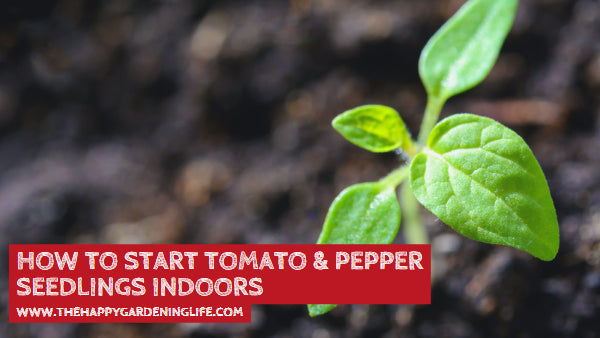
How to Start Tomato & Pepper Seedlings Indoors
Share
 There are many reasons why you should grow your tomato and pepper seeds indoors first. First of all, both of these plants are considered summer vegetables. This means they won’t grow properly unless the soil temperature is greater than 65°F. The temperature of the soil is very important for their growth and if you just plant them right away without considering the wind, soil and weather conditions, then chances are they won’t grow very well.
There are many reasons why you should grow your tomato and pepper seeds indoors first. First of all, both of these plants are considered summer vegetables. This means they won’t grow properly unless the soil temperature is greater than 65°F. The temperature of the soil is very important for their growth and if you just plant them right away without considering the wind, soil and weather conditions, then chances are they won’t grow very well.
So it's beneficial to give your seedlings a nice head start by growing them inside your home early in spring. By late spring, your tomato and pepper seedlings should be strong enough to be transplanted in the warmer outdoor soil and after a while, you can begin your harvest before fall arrives.
As you can see, starting your tomato and pepper seedlings indoors is very crucial. So if you want to get the very best results for your produce, go ahead and follow these easy steps now!
8 Steps to Starting Your Tomato & Pepper Seedlings Indoors
1. Find Out When to Start
First and foremost, you need to find out the right time to begin your indoor growing. This period will of course depend on where you live, but a good rule of thumb is to start the seeds around two months prior to the last spring frost date. You can use online resources such as Almanac.com to help you determine this.
2. Gather Your Materials
You need the following to successfully grow your seedlings indoors:
- Small, clean pots or planting containers with small drainage holes. They should also have a minimum depth of three inches.
- High-quality seed starting mix which you can purchase from a reputable nursery near you. Never use the soil from your garden because they’re too heavy for seedlings and often prone to soil-based diseases, weed seeds and other harmful elements.
- A greenhouse, a window that gets a lot of sunlight, or a room with a good lighting system.
- Some high-quality fertilizer.
- Good air circulation.
3. Prepare the Starting Mix
Now, let’s start by mixing your seed starter. Get a large container, add in the seed starter, gradually pour in some water and mix them properly. The mixture should not be muddy but rather damp like a sponge that has been squeezed out. Once you’ve achieved this, you can go ahead and put the mixture into each planting container. Be sure to leave one inch of space before you reach the container’s tip. You should also label and date all your containers so you’ll know which is which.
4. Plant the Seeds
Next, create a quarter-inch-deep furrow in every container where you can bury the seeds. The seeds should also have an inch’s space between them.
5. Germinate, Water and Monitor the Seedlings
Tomatoes and peppers require high temperatures to get them to sprout. This means you’ll have to put them in a warmer area like in a greenhouse or atop the fridge. You could also set up your own lighting system by using fluorescent bulbs. Simply suspend them one or two inches over the seedlings to provide heat. Make sure the lights aren’t too distant though, otherwise the stems will grow too long and weak.
As to watering, see to it that the containers are always damp and the seedlings are regularly sprinkled with light water.
Lastly, closely monitor the growth of the seedlings and put them in a good light source as soon as they sprout. You can begin raising the light bulbs a little higher once the seedlings start to grow. Watch out for the weak-looking seedlings because they probably need more lighting.
6. Transplanting the Seedlings
Once the sprouts are about three inches in height, you can begin transplanting them to their very own pots to give them more space for growth. Go ahead and put in some dampened mix into each new pot. Dig a hole, carefully move the each tomato or pepper seedling in there from their previous container and water them a bit to stabilize them with the soil.
7. Feeding Your Tomato & Pepper Seedlings
Seed starters actually have very little plant food, so you’ll have to start feeding your tiny plants right away. You can use a liquid fertilizer for this purpose, or whatever your local nursery recommends. Don’t forget to keep providing a steady light source for your growing plants.
8. Moving Your Plants to the Garden
In about a month after this, the weather should be warm enough that you can finally introduce your seedlings to your garden environment. On the first day, simply place the plants in a shaded area for half of the day. On the second and third days, you can put them outside but with shade throughout the day. On the succeeding days, you can eventually place them under the morning sun and then all throughout the day without shade. When they’re ready to be transplanted to the garden, do it around sunset or a cloudy day to reduce stress on the plants. Lastly, secure the plants in the soil, give them enough water and add some organic matter if you like.
And that’s how to start tomato and pepper seedlings indoors properly. The process may be quite long, but just be patient and you’ll be rewarded with some amazing crops that you can be proud of!
